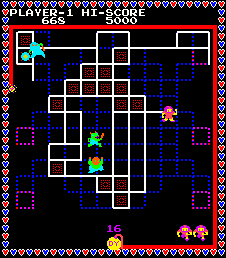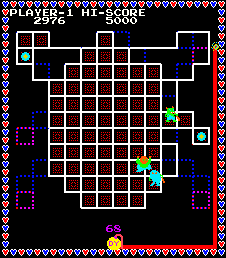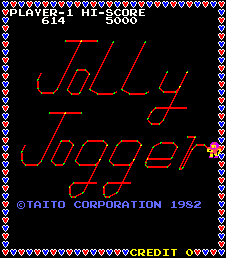 The Game: Players control the Jolly Jogger as he attempts to draw borders around every square area on the playing field. There are several special squares which temporarily give Jolly Jogger the ability to freeze his pursuers for a while; at all other times, they are to be avoided at all costs. Running around every square on the screen clears that level and introduces a new maze of squares where the process begins anew. A lit fuse counts down the time available to Jolly Jogger to complete each screen; if time runs out, a life is lost. (Taito, 1982)
The Game: Players control the Jolly Jogger as he attempts to draw borders around every square area on the playing field. There are several special squares which temporarily give Jolly Jogger the ability to freeze his pursuers for a while; at all other times, they are to be avoided at all costs. Running around every square on the screen clears that level and introduces a new maze of squares where the process begins anew. A lit fuse counts down the time available to Jolly Jogger to complete each screen; if time runs out, a life is lost. (Taito, 1982)
Memories: With a setup and a play mechanic similar to Pepper II and Amidar, Jolly Jogger doesn’t seem to have been a high priority for Taito – even the sell sheet distributed to entice arcade operators and distributors to buy the game seemed lackluster and generic, as if Taito knew it had a game that wasn’t really worthy of prime arcade real estate.
 It’s not that there’s anything terribly wrong with Jolly Jogger, but the games whose play mechanics it “borrowed” – the “fill up every area on the screen” element of Pepper II and Amidar …they’re not exactly first-string games whose machines were constantly occupied by players lining up around the block to put a quarter in. Jolly Jogger was an imitation of a couple of second-string games. Ouch.
It’s not that there’s anything terribly wrong with Jolly Jogger, but the games whose play mechanics it “borrowed” – the “fill up every area on the screen” element of Pepper II and Amidar …they’re not exactly first-string games whose machines were constantly occupied by players lining up around the block to put a quarter in. Jolly Jogger was an imitation of a couple of second-string games. Ouch.
What is there about this game to remember? Its tinkling music is a bit of an earworm. The aggravation of trying to get the controls to respond to repeated, rapid-fire changes of direction is also memorable, for all the wrong reasons. (With its strict, grid-based playing field, the best thing to do with Jolly Jogger would be to create a zig-zag pattern that would allow the filling of many blocks with a single vertical or horizontal line afterward; naturally, the controls don’t make this easy.)
 Jolly Jogger comes off, in the end, as a product that – at any other time – would’ve been in beta testing. But in 1982, with the arcade boom at its peak (and about to begin a slow and painful withdrawal), the release of this game makes it look as though Taito was desperate to just get
Jolly Jogger comes off, in the end, as a product that – at any other time – would’ve been in beta testing. But in 1982, with the arcade boom at its peak (and about to begin a slow and painful withdrawal), the release of this game makes it look as though Taito was desperate to just get  some kind of product out the door, churning out as many new titles as possible in the hopes that something would “stick.” The sheer abstract obscurity of Jolly Jogger worked against it, however, and the very soft support from Taito’s sales department makes it easy to assume that the company knew Jolly Jogger was dead on arrival.
some kind of product out the door, churning out as many new titles as possible in the hopes that something would “stick.” The sheer abstract obscurity of Jolly Jogger worked against it, however, and the very soft support from Taito’s sales department makes it easy to assume that the company knew Jolly Jogger was dead on arrival.